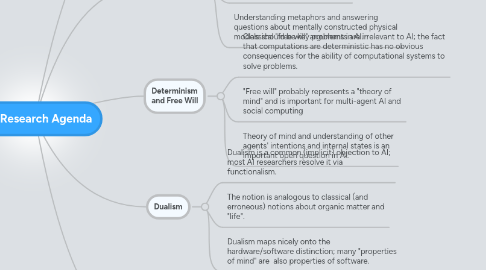
1. Turing Test
1.1. Natural language understanding, social computing and interaction as AI research topics.
1.2. Current AIs fail at "internal world model problems", metaphor.
1.3. Understanding metaphors and answering questions about mentally constructed physical models should be key problems in AI.
2. Self
2.1. Self, consciousness are important aspects of intelligence.
2.2. Psychology, neurobiology, and philosophy give us some clues about what "self" is and isn't.
2.3. How can we translate this into AI architectures?
3. Dualism
3.1. Dualism is a common (implicit) objection to AI; most AI researchers resolve it via functionalism.
3.2. The notion is analogous to classical (and erroneous) notions about organic matter and "life".
3.3. Dualism maps nicely onto the hardware/software distinction; many "properties of mind" are also properties of software.
4. Determinism and Free Will
4.1. Classical "free will" arguments are irrelevant to AI; the fact that computations are deterministic has no obvious consequences for the ability of computational systems to solve problems.
4.2. "Free will" probably represents a "theory of mind" and is important for multi-agent AI and social computing
4.3. Theory of mind and understanding of other agents' intentions and internal states is an important open question in AI.
5. Simulation
5.1. Simulated realities and AI are closely related issues.
5.2. If strong AI is true, AIs will likely exist in simulated realities.
5.3. Simulation is important both in the creation of AI (testing, learning, artificial evolution), and for internal modeling of the world.
6. Approaches to AI Research
6.1. Engineering Approach
6.1.1. subdivide the problem into subproblems
6.1.2. understand and solve each subproblem
6.1.3. assemble the solutions into an overall solution
6.1.4. assumptions
6.1.4.1. the details of hardware or implementation don't matter
6.1.4.2. intelligence can be decomposed in this way and consists of a large number of specialized solutions to identifiable problems
6.2. Neuromorphic Approach
6.2.1. understand the low level architecture of the brain
6.2.2. simulate it and train it, just like a real brain
6.2.3. assumptions
6.2.3.1. architectural details may matter
6.2.3.2. intelligence consists of a few general purpose modules and is an emergent property
6.3. Artificial Evolution Approach
6.3.1. create a simulated artificial environment
6.3.2. populate it with simulated agents capable of mutation, replication, and competition
6.3.3. select for desired traits
6.3.4. assumptions
6.3.4.1. architectural details don't matter
6.3.4.2. intelligence consists of a few general purpose modules and is an emergent property
6.4. Uploading Approach
6.4.1. determine the detailed architecture and structure of human brains down to the level of individual neurons
6.4.2. simulate this structure to the necessary level of detail
6.4.3. assumptions
6.4.3.1. intelligence and memory are relatively robust property and are encoded in connections and channel densities in the brain
6.4.3.2. chaos and quantum effects do not matter to intelligent behavior
